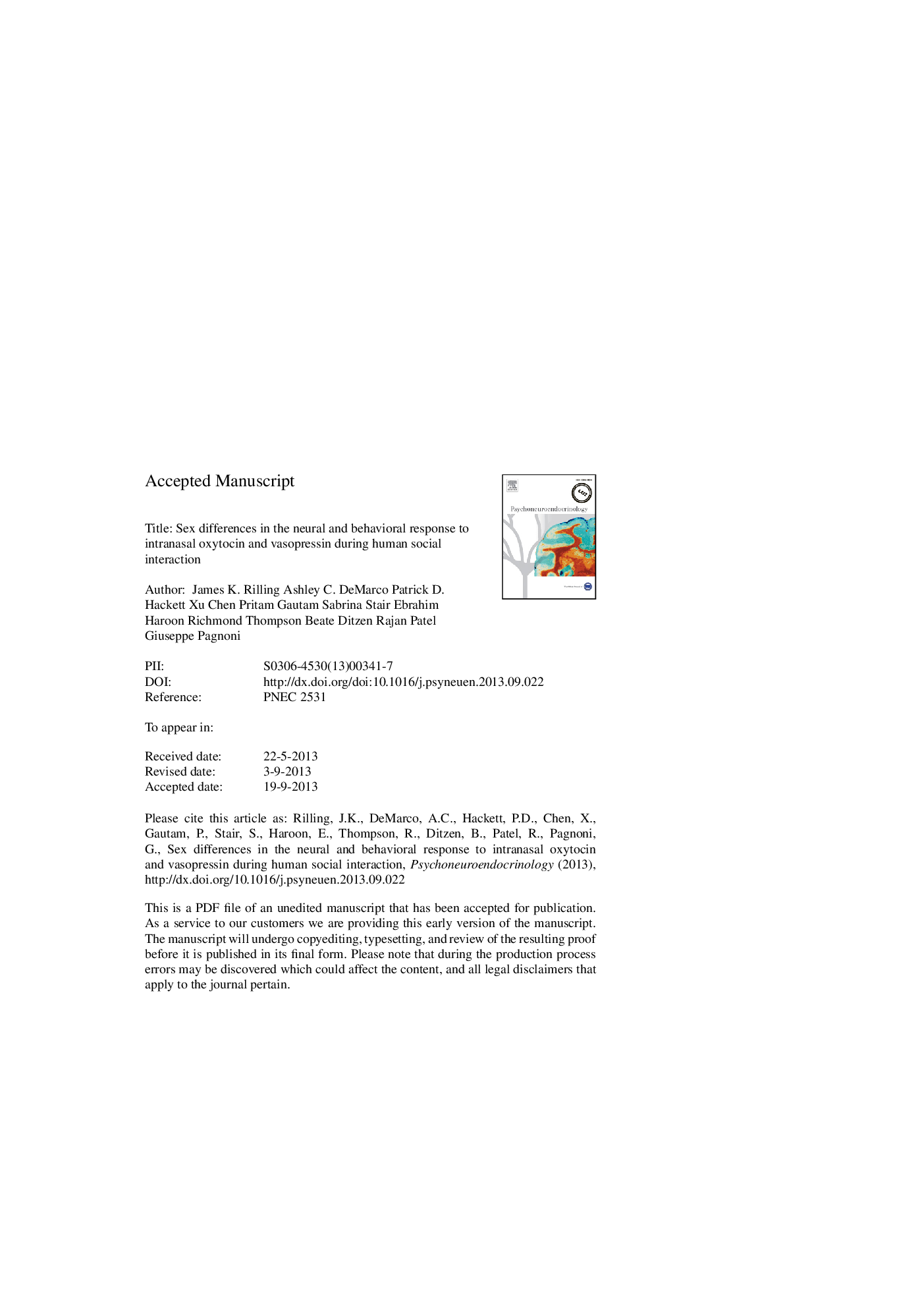| کد مقاله | کد نشریه | سال انتشار | مقاله انگلیسی | نسخه تمام متن |
|---|---|---|---|---|
| 6819917 | 547134 | 2014 | 47 صفحه PDF | دانلود رایگان |
عنوان انگلیسی مقاله ISI
Sex differences in the neural and behavioral response to intranasal oxytocin and vasopressin during human social interaction
ترجمه فارسی عنوان
تفاوت جنسیتی در پاسخ عصبی و رفتاری به اکسایتوسین اینترنال و وازوپرسین در طول تعامل اجتماعی انسان
دانلود مقاله + سفارش ترجمه
دانلود مقاله ISI انگلیسی
رایگان برای ایرانیان
کلمات کلیدی
موضوعات مرتبط
علوم زیستی و بیوفناوری
بیوشیمی، ژنتیک و زیست شناسی مولکولی
علوم غدد
چکیده انگلیسی
Both oxytocin (OT) and vasopressin (AVP) are known to modulate social behavior, and dysfunction in both systems has been postulated as a potential cause of certain psychiatric disorders that involve social behavioral deficits. In particular, there is growing interest in intranasal OT as a potential treatment for certain psychiatric disorders, and preliminary pre-clinical and clinical studies suggest efficacy in alleviating some of the associated symptoms. However, the vast majority of research participants in these studies have been male, and there is evidence for sexually differentiated effects of nonapeptides in both humans and non-human animals. To date, no study has investigated the effect of intranasal OT on brain function in human males and females within the same paradigm. Previously, in a randomized, placebo-controlled, double-blind fMRI study, we reported effects of intranasal OT and AVP on behavior and brain activity of human males as they played an interactive social game known as the Prisoner's Dilemma Game. Here, we present findings from an identical study in human females, and compare these with our findings from males. Overall, we find that both behavioral and neural responses to intranasal OT and AVP are highly sexually differentiated. In women, AVP increased conciliatory behavior, and both OT and AVP caused women to treat computer partners more like humans. In men, AVP increased reciprocation of cooperation from both human and computer partners. However, no specific drug effects on behavior were shared between men and women. During cooperative interactions, both OT and AVP increased brain activity in men within areas rich in OT and AVP receptors and in areas playing a key role in reward, social bonding, arousal and memory (e.g., the striatum, basal forebrain, insula, amygdala and hippocampus), whereas OT and AVP either had no effect or in some cases actually decreased brain activity in these regions in women. OT treatment rendered neural responses of males more similar to responses of females in the placebo group and vice versa, raising the prospect of an inverted u-shaped dose response to central OT levels. These findings emphasize the need to fully characterize the effects of intranasal OT and AVP in both males and females and at multiple doses before widespread clinical application will be warranted.
ناشر
Database: Elsevier - ScienceDirect (ساینس دایرکت)
Journal: Psychoneuroendocrinology - Volume 39, January 2014, Pages 237-248
Journal: Psychoneuroendocrinology - Volume 39, January 2014, Pages 237-248
نویسندگان
James K. Rilling, Ashley C. DeMarco, Patrick D. Hackett, Xu Chen, Pritam Gautam, Sabrina Stair, Ebrahim Haroon, Richmond Thompson, Beate Ditzen, Rajan Patel, Giuseppe Pagnoni,
